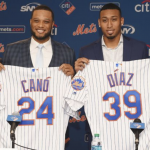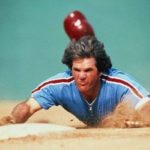Baseball: What the Hell Is Happening?
 Part one of a three-part investigation
Part one of a three-part investigation
On the surface, everything in baseball seems fairly normal as we head down the stretch of this season, However, over the past few months, I have seen more articles about baseball’s on- and off-field problems than ever before. Many of the top sportswriters have tossed in their two cents.
- Joel Sherman of the New York Post: Grass or Dirt: The First Step to Fixing the Shift in Baseball.
- Tom Verducci of Sports Illustrated: There Are Too Many Strikeouts in Baseball.
- Tyler Kepner of the New York Times: Even at the All-Star Game the Off-Season Standoff Still Stings.
- And Buster Olney of ESPN: Parts of Baseball are Disappearing Before our Eyes.
So, if all of these fine writers who cover the game daily are noticing, then there must be something to notice. This is not a review of these articles; I listed them because they were a catalyst to encourage me to try my hand at the problem. The reporting that got me started was written by Tyler Kepner, who focused on MLB’s off-the-field problems.
“The convergence of power pitchers, power hitters and analytics has slowed the game, with strikeout rates at an all-time high and batting averages at a 46-year low.” I was not surprised. But then Kepner added: “Twenty-one of the 30 teams have experienced an attendance drop this season, and league-wide attendance is down by 1,735 fans per game.”
I wondered why.
So, let’s look at the fundamentals. In a basic sense, the game has not changed much. There’s still a pitcher—the catalyst of the game—in the center of the diamond throwing a ball 60 feet, six inches to a batter waiting at home plate. If the batter does not swing at the ball, a catcher will catch it (most of the time) and an umpire standing behind the catcher will call a ball or strike. This completes the triad behind home plate. Even though the players and umpires change, this triad is the fundamental unit of action.
This is where the vast majority of plays begin. I say vast majority, because the pitcher does occasionally throw to first base to keep a runner from getting a big lead. And even more infrequently than that, the pitcher might throw to second base to try and pick off a runner. And even less frequently than that, a catcher might throw to any of the bases to push a runner back to the base, if not trying to pick the runner off, outright. So, this locus in the center of the diamond has not changed.
Classic batteries over the years have featured Whitey Ford and Elston Howard. Don Newcombe and Roy Campanella. Tom Seaver and Jerry Grote. Ron Guidry and Thurman Munson. Bill Lee and Carlton Fisk. Bob Gibson and Tim McCarver. Steve Carlton and Tim McCarver. And so many more. This is where the game begins.
And most of the finest pitchers in the game throw/threw unhittable pitches, which create strikeouts. Strikeouts that are now one of the most pressing problems in the game.
Verducci writes that strikeouts are on the rise for the 13th consecutive season. While that’s great for pitchers, strikeouts are inefficient for hitters because—though they’ve made an out, and hitters make many outs over the course of a season—strikeouts are unproductive because the ball has not been put into play. There’s no chance for a hit, an error or any other event to advance a runner on base. And if there was a rally in progress, the out hasn’t changed the circumstances. But, of course, there’s more to baseball’s ills than merely strikeouts.
Let’s take a look. Since I am not a baseball columnist, my route may be a bit circuitous and my conclusions a bit different than the writers who focus on the field, rather than the entire business, of baseball.
Baseball as Entertainment: A Bit of History
That’s right, baseball is not merely a sport, it’s entertainment, and it competes for the entertainment dollar like every other variation on the theme. Fifty years ago, it was the big fish in a small pond. It was America’s national pastime and the number one sport. Now, that’s not the case.
There are entertainment choices galore. Many of these choices are now delivered to homes through cable television and wireless internet. Choices like Netflix, Hulu, YouTube, podcasts, cable news programming and web programming like PBS.org. Video games can be played on computers, smart phones, Xboxes, or Sony PlayStations, as well as over the internet in networked contests against other users.
Adding to this menu are entertainment options outside the home: movies, theater, restaurants and other sporting events, like the NFL, NBA, NHL and soccer (or football, as it’s known outside the United States). While baseball may be the national pastime, it’s not alone anymore. In short, baseball is competing for eyeballs—and if there’s not enough intrigue and suspense in a game, viewers can turn elsewhere to satisfy their thirst for excitement.
The recent World Cup was such a major event, yet it was a nonentity in the United States in the ’60s and ’70s. If any of the matches were shown, I don’t remember seeing them on American television. But every contest of the 2018 tournament was carried live in the United States, and while the ratings for the initial round contests were lower than in 2014, subsequent knockout matches gained in popularity—culminating in the final match, which drew high ratings on American television.
Watching the World Cup, despite its exciting moments, I found myself channel surfing between the game and other baseball games on at the same time. Maybe that’s just me. Because of baseball’s slow pace, I could return to the match for minutes at a time and when I changed back to the baseball game, I could grasp the circumstances of the game at a moment’s glance.
The sports networks have made this immeasurably easier by placing a graphics box in a corner of the screen with the score, top or bottom of the inning, number of outs, pitch count, number of pitches thrown and even the velocity of pitches. So, one look at that box and any serious baseball fan will know exactly what is happening in the game.
Back in the Day …
When I grew up with baseball in the 1960s, there were none of these contrivances. There were only seven channels on television sets in New York City. Three networks, three independents and public television. Home games were broadcast on independent stations, and only one game of the week was broadcast on national network television (NBC) on Saturday afternoons.
I’ll never forget the voices of Curt Gowdy and Tony Kubek, who broadcast no-nonsense baseball. The commentary was about the game and only the game. Kubek was the former Yankees shortstop who played on three World Series champions and was famously hit in the throat by a bad-hop ground ball in the bottom of the eighth inning of game seven of the 1960 World Series. That directly led to the Pittsburgh Pirates tying the game and then going on to win the Series in the bottom of the ninth when Bill Mazeroski led off with an equally famous walk-off, Series-winning home run, clinching a 10-9 victory.
So, Kubek not only loved the game, he had the moxie to understand its strategic nuances and speak in earnest about the players and which team he expected to win and why. His broadcast partner, Gowdy, described the action as if he was on a Wyoming bronco fresh off the range, kicking up dust as it circled the corral. Gowdy loved the game.
There was none of the carnival barking in the broadcast booth that ESPN and FOX bring to today’s telecasts that cheapens the product. Of course, there was no such thing as a 24/7 sports network, or even a 24/7 news network. The idea was years away.
Nor had prime-time football arrived yet. Only NFL road games were broadcast Sunday afternoons. Home games would still be blacked out until after the NFL-AFL merger in 1970. Baseball was still atop of the heap, but football was gaining yardage. Mostly because football had chosen a visionary commissioner in Pete Rozelle, an advertising man who understood marketing communications. He knew football was not merely a sport, but an entertainment product that could be sexied up and made even more exciting, so it would be packed with thrilling moments that could be marketed to fans and the networks (already customers) for more money.
Contrast this with baseball’s uninspired leadership at the time. The new baseball commissioner in the mid-late ’60s, after the death of the previous Commissioner Ford Frick, was a nondescript, bland and lackluster US Air Force Lieutenant General. William Eckert knew nothing about baseball, had not seen or attended a baseball game since the mid-’50s and was named Commissioner (1965-1968) after another General, friendly with some of the owners, recommended him.
Eckert was succeeded by Bowie Kuhn in 1968. Kuhn proceeded to do his best Rip Van Winkle impersonation over the following 15 years. It was under Kuhn’s watch that Marvin Miller outlawyered him, upended the Reserve Clause and forever changed baseball economics, freeing the players from the owners’ iron grip on their careers and artificially low compensation. No wonder some owners felt Kuhn should’ve remained a scoreboard operator at Griffith Stadium in Washington, D.C., where he once worked as a boy for a dollar a day.
Compared to the growth of the NFL during the ’70s and ’80s, baseball was stationary. NFL telecasts were events not to be missed. Granted, the NFL played once a week, so there was a limited supply of content compared to baseball games played six or seven times a week. Still, baseball did not have the luster of an NFL game. And, to make matters worse, baseball had labor issues on the horizon and its cost structure of guaranteed contracts and limited player movement via free agency made it more difficult to control the direction of the game.
Football had a salary cap, no free agency and its labor relations were under control. Baseball could only wish it had football’s non-guaranteed and limited contractual obligations. After the baseball Reserve Clause was abrogated in 1975, money and more money became a real problem over time, as we shall see in this discussion.
One of the famous stories of the game during the reign of the Reserve Clause was the predicament of one Ralph Kiner, a Hall of Fame outfielder for the Pittsburgh Pirates (for most of his career) who either led or tied for the lead in home runs hit in the major leagues between 1946 and 1952. Kiner led the National League with 47 home runs in 1950. After the season, he attempted to renegotiate his salary with the notoriously brilliant but stingy 69-year-old General Manager of the Pirates who could’ve easily been confused for a clergyman: Branch Rickey.
Rickey supposedly glared after Kiner’s request for a salary increase. Taking his time, Rickey came around to the other side of his desk, leaned against the desktop and told Kiner, [and I paraphrase] “Look, we finished last with you, we can finish last without you.” And to add insult to injury, Rickey offered Kiner a new contract for less money than he had earned the prior season. Kiner signed it. What choice did he have?
By the 1960s, a few years after the New York Giants and Brooklyn Dodgers had moved to the West Coast, National League baseball games began broadcasting across the country (broadcasts in New York began after 1962 when the expansion New York Mets opened for business). Broadcasts were, more often than not, on the radio in New York City than television. Though, the odd game was shown on television. But for those who could not stay up late, yet wanted to know the final score, the only place to look was at the box scores in the morning newspapers or listen to the local sports report on the radio.
Which is why I often went to bed with an AM transistor radio under my pillow and the tinny sounding play-by-play that brought the game alive coiling through the earplug cushioned into my ear. The announcer’s call was in many ways more exciting than watching the game itself, since imagination could be so vibrant—just as anticipation was thrilling. Against this late-night backdrop, the announcers created the world of baseball as I fell asleep. But when I awoke I had no idea how the game ended.
Of course, many times the early morning paper would not print the late box scores since they had yet to arrive before the edition was printed, so there was no record of late games or updated standings. Standings often printed in the paper were based on the prior day’s final results.
Unimaginable today.
Those days, box scores were like religious texts to baseball fans. And every major newspaper printed as many as nine or ten box scores if all the teams played on the same day. Box scores were the only way to decode the game (other than the beat writer’s story which might not run until the following day). So, how long the game was, how the starting pitchers performed, which hitters had a great night and which player won or lost the game. A key home run. Errors. All the pertinent information was in that box score.
MLB All-the-Time Loses Its Luster
Today it’s questionable if fans even know what a box score is.
Why? Because today sports reporting is so sophisticated (and profitable) that 24/7 networks, even for sports, are viable businesses. In the United States, there are two major networks: ESPN and FOX Sports. And the MLB Network competes with them, running a 24/7 operation year-round. Depending on the time of the evening, or morning, the MLB recap show, QuickPitch, may be on. And while even QuickPitch can be overloaded with too much information, at least it’s all baseball. During the season, of course, no one covers baseball the way MLB does. Its telecast is now as sophisticated as ESPN’s—in many ways, it mirrors the quality of the ESPN format.
Baseball, the game on the field, is not as glittering or suspenseful, and that is the problem.
The 24/7 sports networks (like the equivalent news networks) are part of the information overload problem today. They provide never-ending streams of (useless) information and demand eyeballs all the time for the next tidbit, no matter how unimportant. Baseball has figured a way around this: the MLB free At Bat app that runs on mobile devices. In many ways, it’s like the old sports section of a newspaper; but it’s an interactive, online, real-time information product that responds to what I want to know.
When I click on At Bat, I immediately go to the Scoreboard feature to see every score of every game, in real-time. And there it is: the score I was looking for. Then I can check the Standings and it’s always up-to-date information. Perfect. All the scores, stats and videos of the games are at my fingertips, and I can see only what I want and then turn it off. Finally, a way around information overload. Someone at MLB got this one right. Now, if they could only fix the game.
I use At Bat when I don’t watch games from beginning to end because I tend to switch channels. To other baseball games. News shows. Movies. The occasional old television show that’s on every night at the same time. And that’s because there are so many choices. I know if I miss the action of a baseball game, I can always see it later in several places: The game itself, MLB At Bat, and even the story in the online newspaper that embeds video of the game into the story. So, many choices to see the few explosive moments.
I guess this is a way to get around the lack of action. Watch some of the game. And change the channel when the game is settles into a long, boring phase. Then later choose one of the many options to see the key moments after it’s ended. I’m sure baseball did not create At Bat as a substitute for watching or attending games. But that may be the case. It’s baseball in short, digital bursts. And it’s very attractive.
Now, if only the games were as exciting …
Next up: Baseball, how it got where it is today. The Reserve Clause.

























